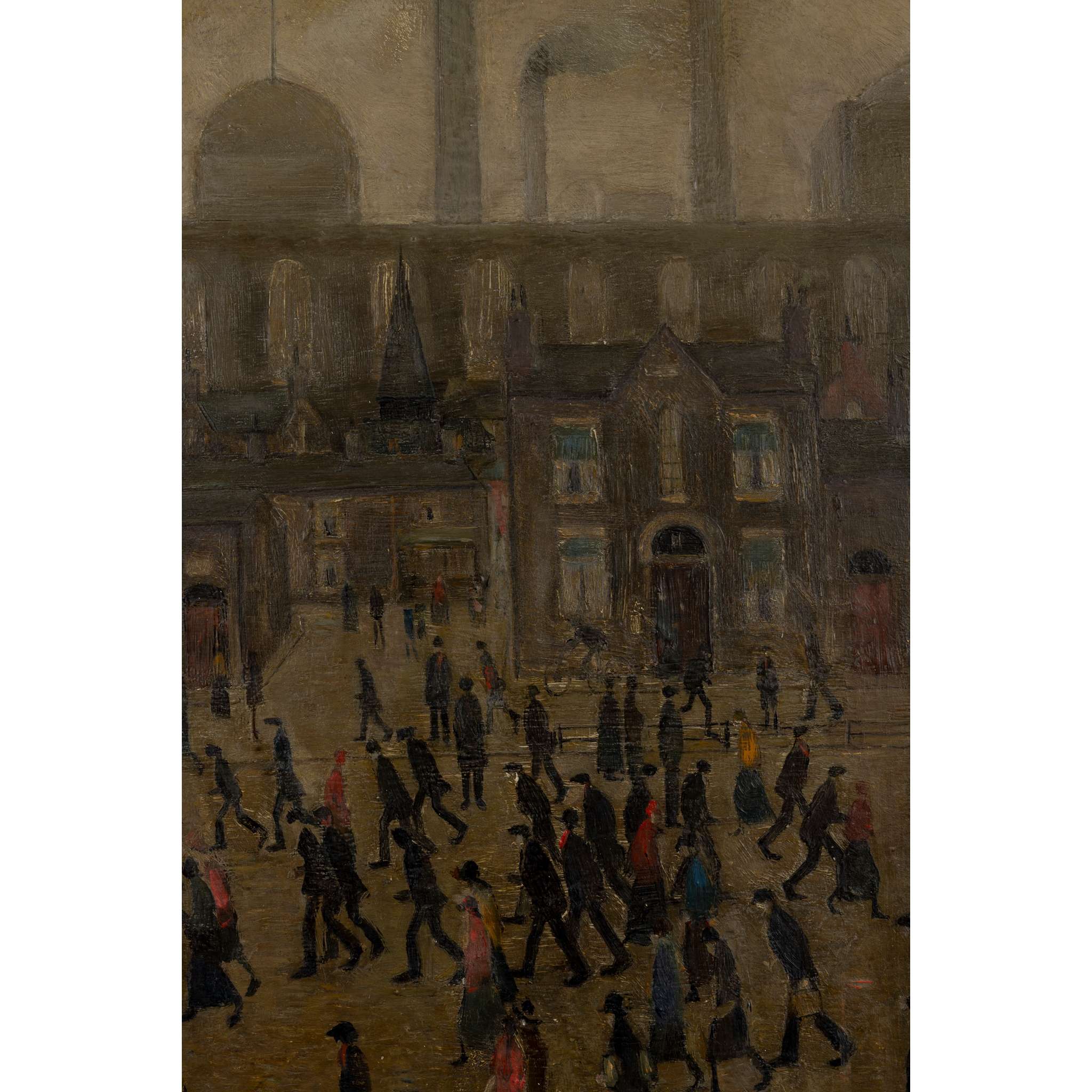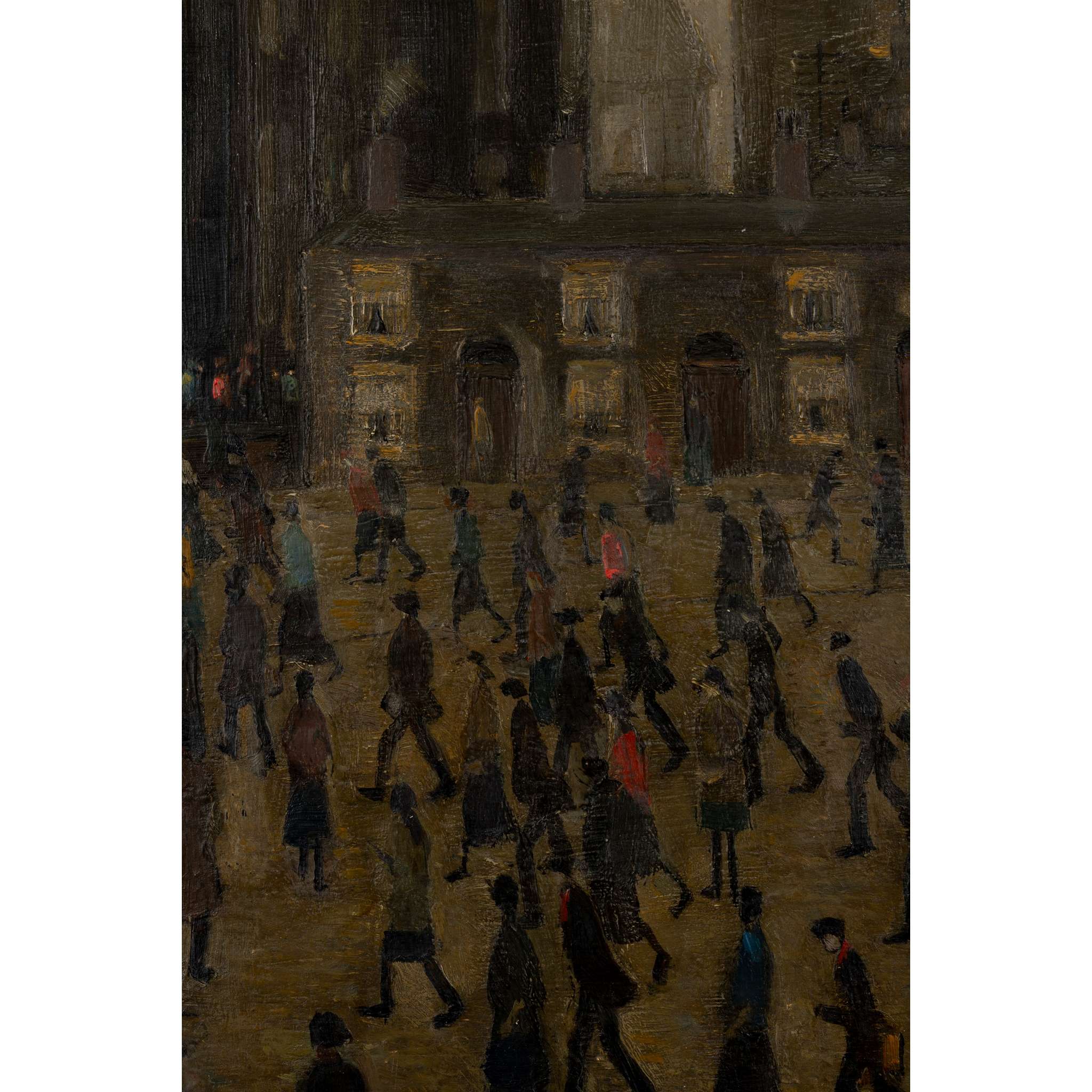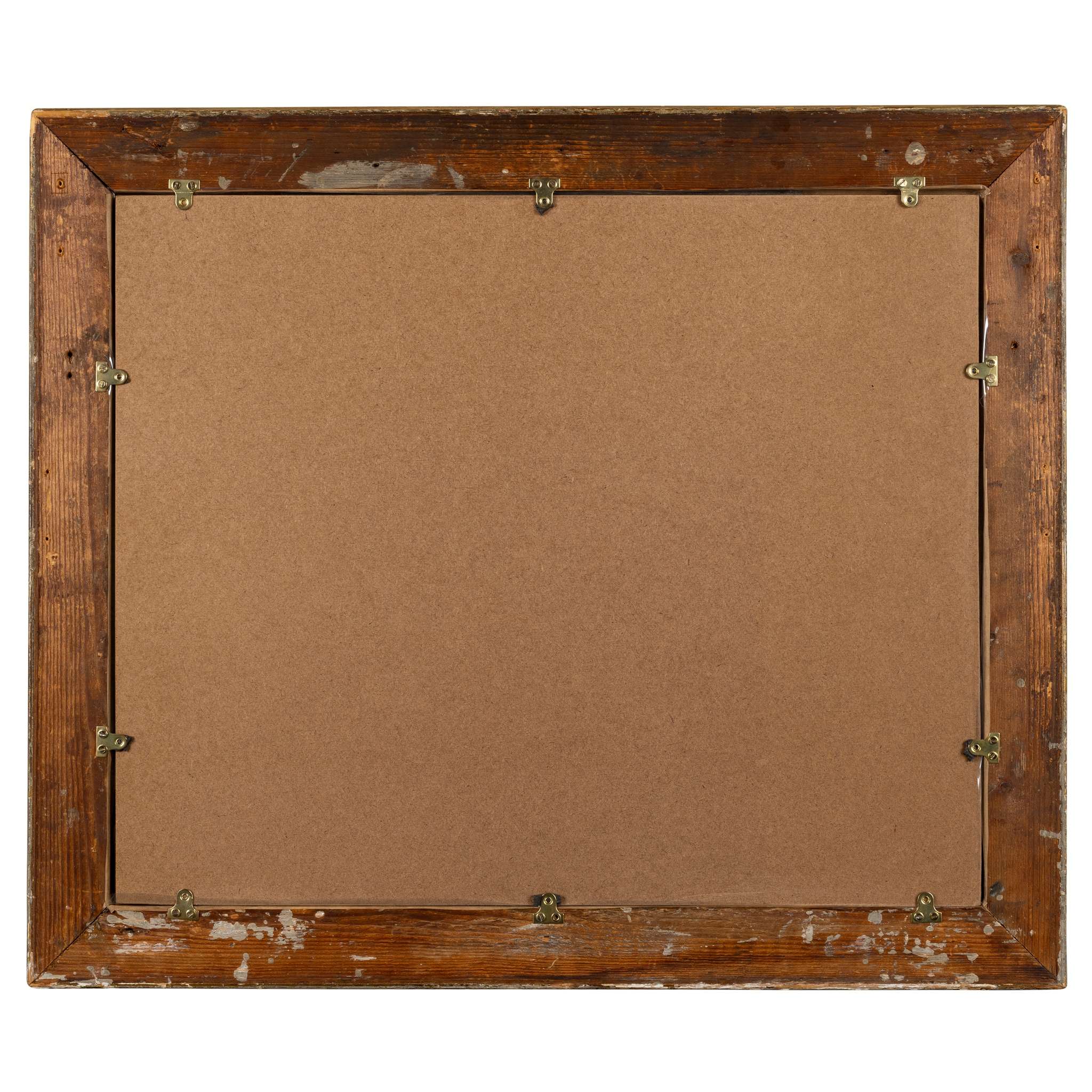124
§ LAURENCE STEPHEN LOWRY (BRITISH 1887-1976)
Sie sind dabei, ein Gebot in Höhe von GBP abzugeben.
Startpreis : GBP
Gebote sind ohne Steuern, Aufgeld oder Versankosten.
By confirming your bid, you agree that you have read and accepted the-saleroom.com and the auctioneer's terms and conditions. Confirming your bid is a legally binding obligation to purchase and pay for the lot should your bid be successful.
Please note: you can manage your bids before the auction starts in My Saleroom. Ihr Maximal Gebot kennen nur Sie.
Wählen Sie eine der folgenden Schnellgebotsoptionen:
Gebote sind ohne Steuern, Aufgeld oder Versankosten.
By confirming your bid, you agree that you have read and accepted the-saleroom.com and the auctioneer's terms and conditions. Confirming your bid is a legally binding obligation to purchase and pay for the lot should your bid be successful.
Please note: you can manage your bids before the auction starts in My Saleroom. Ihr Maximal Gebot kennen nur Sie.
GOING TO THE MILL, 1925
signed and indistinctly dated (lower left), oil on panel
43.2cm x 53.4 cm (17in x 21in)
Acquired directly from the Artist by A.S. Wallace, 1926, and thence by descent to the present owner.
Exhibited:On long-term loan to Pallant House Gallery, Chichester, 2013-2024L S Lowry’s early masterpiece Going to the Mill was painted a hundred years ago and, quite remarkably, has been in the same private family collection for all but one of those hundred years. It was acquired directly from Lowry by the journalist A.S. Wallace, an editor at the Manchester Guardian who had illustrated three of Lowry’s works in the special ‘Manchester Civic Week’ supplement published by the paper. Civic Week was held from the 2nd to the 9th of October 1925, ostensibly to celebrate Manchester’s industrial success, but also with an ulterior motive to discourage the city’s disgruntled workers from going on strike. It was the grim nature of the workers’ lives that, of course, interested Lowry, but which also made it hard for him to find an audience for his visual elegies of the industrial city – a concept that is perhaps hard to fathom now, for those of us that have grown up knowing Lowry as one of Britain’s most celebrated ‘painters of modern life’. During Civic Week, Lowry’s works were displayed in Lewis’s department store, where they were mostly passed by – despite the favourable reviews the Guardian had given his first solo show in 1921. A.S. Wallace, however, fell for Lowry’s depictions of the ‘lovely, ugly town’ (to borrow from Dylan Thomas’s description of his hometown of Swansea), striking up a friendship with the artist and asking to buy one. Lowry duly obliged: Going to the Mill is marked on the back as being £30 – Lowry let Wallace have it for £10. If not his first ever sale, this has to have been one of his earliest. He also threw in an additional work - The Manufacturing Town. The Wallace family still have Lowry’s letter of 9th November 1926, in which the artist writes: ‘Many thanks for your letter and cheque £10. I am very glad Mrs Wallace likes the picture Going to Work and take the liberty of asking you to please accept The Manufacturing Town as a souvenir of the Civic Week. I can assure you that it will always be with great pleasure that I shall think of that Saturday morning.’ The latter painting was sold by the Wallace family – with Lowry’s blessing, as he understood that a new generation of the family needed help getting set up – and is now in the collection of the Science Museum in London. Going to the Mill was kept – recently being on long term loan to Pallant House Gallery, Chichester, and only comes to market now as a further generation finds themselves in need of a ‘leg up.’Going to the Mill is the epitome of a 1920s Lowry, when he truly becomes a unique voice. In the overall smoky, sooty quality of the sky and buildings – it will be a few years yet before Lowry begins to stage his visions of the city against isolating backgrounds of plain flake-white – we see the influence of his teacher, Alphonse Valette, who had been drawn to Manchester precisely for its grit and the Romantic quality of its dark streets and thick polluted skies, the poetic fallacy of heavy-set architecture shrouded in smog, from which individual stories emerged, lamp-lit for moments, before being swallowed up by the gloom. Yet Lowry holds our attention to these individual lives much longer (and this is eventually the function of those white backdrops, to separate individuals from the mass and to hold them in time). Looking at Going to the Mill, initially all we see is a crowd, drawn inextricably – like water pouring towards a drain – to the gate of the mill on the left. But Lowry invites us to spend time looking, and slowly the painting reveals the men walking away from the mill, the woman standing alone looking out at us, drawing the viewer into the lives of others, or the man carrying what seems like a large portfolio, who could be an avatar of Lowry himself. As such, the crowd is broken down into individuals, each with a story – a story that Lowry himself manages to capture with a flick of the brush, a weighting of the paint, a bend of the knee or turn of the shoulder. Going to the Mill shows us that he is no naif painter of ‘matchstick men and matchstick cats and dogs’ as the old pop song goes – this is an artist of true dexterity who is making a deliberate formal choice, abstracting the figure, in order to express a concept, the sense of a life lived in even the smallest, most incidental figure. His works are as composed and deliberate as Seurat’s A Sunday on La Grande Jatte but imbued with an intensity of feeling more easily found in Van Gogh’s early paintings of Dutch peasants. These comparisons are not over-blown, not least as Lowry, in the early 30s, was one of the very few British artists exhibiting in the Salon in Paris and gaining recognition for the precision and intensity of his vision. And it is important to note that it was T. J. Clark, the great art historian of French painting of the late 19th and early 20th century, who curated Lowry’s 2014 Tate retrospective and presented Lowry deliberately as another of the great ‘painters of modern life’.Lowry’s paintings are never simple renditions of what he saw on the streets of his beloved city (or, more accurately, cities – Salford and Manchester). Works such as Going to the Mill are theatrical in their conception, which is why the ‘backdrop’ of the mill at Pendlebury repeats itself, often in altered configurations, throughout his works – such as the slightly later A Town Square, formerly in the Midland Bank collection, which sold at Sotheby’s in 2024. The city becomes a stage for an exploration of loneliness, isolation, loss, hope, although in Lowry’s hands the buildings themselves function as actors – figuring birth, marriage, death and the tyranny of mill-time, before, in later works, they are enveloped in an all-consuming white of Beckettian structure. Lowry was an inveterate theatre-goer who – intriguingly, instructively – cited both the 1920s ‘kitchen sink’ drama Hindle Wakes and Luigi Pirandello’s absurdist masterpiece Six Characters in Search of an Author as highly influential on his work. The breadth between these two plays indicates the breadth of Lowry’s conceptual framework for his apparently ‘simple’ painting. This conceptual reach, centred on the urban experience, is – as T. J. Clark argues so persuasively - what makes Lowry so relevant today, in our world of megalopolises, many of them growing at the same break-neck speed as Victorian Manchester once did.
GOING TO THE MILL, 1925
signed and indistinctly dated (lower left), oil on panel
43.2cm x 53.4 cm (17in x 21in)
Acquired directly from the Artist by A.S. Wallace, 1926, and thence by descent to the present owner.
Exhibited:On long-term loan to Pallant House Gallery, Chichester, 2013-2024L S Lowry’s early masterpiece Going to the Mill was painted a hundred years ago and, quite remarkably, has been in the same private family collection for all but one of those hundred years. It was acquired directly from Lowry by the journalist A.S. Wallace, an editor at the Manchester Guardian who had illustrated three of Lowry’s works in the special ‘Manchester Civic Week’ supplement published by the paper. Civic Week was held from the 2nd to the 9th of October 1925, ostensibly to celebrate Manchester’s industrial success, but also with an ulterior motive to discourage the city’s disgruntled workers from going on strike. It was the grim nature of the workers’ lives that, of course, interested Lowry, but which also made it hard for him to find an audience for his visual elegies of the industrial city – a concept that is perhaps hard to fathom now, for those of us that have grown up knowing Lowry as one of Britain’s most celebrated ‘painters of modern life’. During Civic Week, Lowry’s works were displayed in Lewis’s department store, where they were mostly passed by – despite the favourable reviews the Guardian had given his first solo show in 1921. A.S. Wallace, however, fell for Lowry’s depictions of the ‘lovely, ugly town’ (to borrow from Dylan Thomas’s description of his hometown of Swansea), striking up a friendship with the artist and asking to buy one. Lowry duly obliged: Going to the Mill is marked on the back as being £30 – Lowry let Wallace have it for £10. If not his first ever sale, this has to have been one of his earliest. He also threw in an additional work - The Manufacturing Town. The Wallace family still have Lowry’s letter of 9th November 1926, in which the artist writes: ‘Many thanks for your letter and cheque £10. I am very glad Mrs Wallace likes the picture Going to Work and take the liberty of asking you to please accept The Manufacturing Town as a souvenir of the Civic Week. I can assure you that it will always be with great pleasure that I shall think of that Saturday morning.’ The latter painting was sold by the Wallace family – with Lowry’s blessing, as he understood that a new generation of the family needed help getting set up – and is now in the collection of the Science Museum in London. Going to the Mill was kept – recently being on long term loan to Pallant House Gallery, Chichester, and only comes to market now as a further generation finds themselves in need of a ‘leg up.’Going to the Mill is the epitome of a 1920s Lowry, when he truly becomes a unique voice. In the overall smoky, sooty quality of the sky and buildings – it will be a few years yet before Lowry begins to stage his visions of the city against isolating backgrounds of plain flake-white – we see the influence of his teacher, Alphonse Valette, who had been drawn to Manchester precisely for its grit and the Romantic quality of its dark streets and thick polluted skies, the poetic fallacy of heavy-set architecture shrouded in smog, from which individual stories emerged, lamp-lit for moments, before being swallowed up by the gloom. Yet Lowry holds our attention to these individual lives much longer (and this is eventually the function of those white backdrops, to separate individuals from the mass and to hold them in time). Looking at Going to the Mill, initially all we see is a crowd, drawn inextricably – like water pouring towards a drain – to the gate of the mill on the left. But Lowry invites us to spend time looking, and slowly the painting reveals the men walking away from the mill, the woman standing alone looking out at us, drawing the viewer into the lives of others, or the man carrying what seems like a large portfolio, who could be an avatar of Lowry himself. As such, the crowd is broken down into individuals, each with a story – a story that Lowry himself manages to capture with a flick of the brush, a weighting of the paint, a bend of the knee or turn of the shoulder. Going to the Mill shows us that he is no naif painter of ‘matchstick men and matchstick cats and dogs’ as the old pop song goes – this is an artist of true dexterity who is making a deliberate formal choice, abstracting the figure, in order to express a concept, the sense of a life lived in even the smallest, most incidental figure. His works are as composed and deliberate as Seurat’s A Sunday on La Grande Jatte but imbued with an intensity of feeling more easily found in Van Gogh’s early paintings of Dutch peasants. These comparisons are not over-blown, not least as Lowry, in the early 30s, was one of the very few British artists exhibiting in the Salon in Paris and gaining recognition for the precision and intensity of his vision. And it is important to note that it was T. J. Clark, the great art historian of French painting of the late 19th and early 20th century, who curated Lowry’s 2014 Tate retrospective and presented Lowry deliberately as another of the great ‘painters of modern life’.Lowry’s paintings are never simple renditions of what he saw on the streets of his beloved city (or, more accurately, cities – Salford and Manchester). Works such as Going to the Mill are theatrical in their conception, which is why the ‘backdrop’ of the mill at Pendlebury repeats itself, often in altered configurations, throughout his works – such as the slightly later A Town Square, formerly in the Midland Bank collection, which sold at Sotheby’s in 2024. The city becomes a stage for an exploration of loneliness, isolation, loss, hope, although in Lowry’s hands the buildings themselves function as actors – figuring birth, marriage, death and the tyranny of mill-time, before, in later works, they are enveloped in an all-consuming white of Beckettian structure. Lowry was an inveterate theatre-goer who – intriguingly, instructively – cited both the 1920s ‘kitchen sink’ drama Hindle Wakes and Luigi Pirandello’s absurdist masterpiece Six Characters in Search of an Author as highly influential on his work. The breadth between these two plays indicates the breadth of Lowry’s conceptual framework for his apparently ‘simple’ painting. This conceptual reach, centred on the urban experience, is – as T. J. Clark argues so persuasively - what makes Lowry so relevant today, in our world of megalopolises, many of them growing at the same break-neck speed as Victorian Manchester once did.
MODERN MADE ft. The Gillian Raffles Collection
Auktionsdatum
Ort der Versteigerung
For more information contact the team on 0207 930 9115 | london@lyonandturnbull.com
----
COLLECTION OF PURCHASED LOTS
Items will be available for collection from the Mall Galleries on Saturday 3rd May 10am - 3:30pm.
Following this, the works will be divided, with works belonging to Scottish buyers/vendors being stored at Lyon &Turnbull, 33 Broughton Place, Edinburgh EH13RR, and works belonging to international or rest-of-UK buyers/vendors moving to Stephen Morris Shipping, 15 Ockham Drive, Greenford, UB6 0FD. Tel 0208 832 2222. Open 9am-5pm by prior appointment only.
LONDON LOT COLLECTION
Items will be available for collection from the Mall Galleries on Saturday 3rd May 10am - 3:30pm.
Following this, items will be available to collect from Thursday 8th May 9am from Stephen Morris Shipping, 15 Ockham Drive, Greenford, UB60FD. They will be stored free of charge until Thursday 22nd May.
From Friday 23rd May clients will be charged by our storage partners:
Insurance 0.25% (all items)
Smalls (paintings and objects) - £2.50 admin fee then £1.00 per day.
Large or furniture pieces - £5.50 admin fee then £2.50 per day.
Stephen Morris Shipping, 15 Ockham Drive, Greenford, UB6 0FD.
Tel 0208 832 2222.
Open 9am – 5pm by prior appointment only.
EDINBURGH LOT COLLECTION
Scottish buyers and vendors items will be available to collect from Friday 16th May at 9am from Lyon & Turnbull, 33 Broughton Place Edinburgh EH1 3RR. All collections must be by appointment only (this applies to both carriers and personal collections). Please book appointments by email at info@lyonandturnbull.com or telephone 0131 557 8844
Wichtige Informationen
BUYER'S PREMIUM
The buyer shall pay the hammer price together with a premium, at the following rate, thereon.
26% up to £20,000
25% from £20,001 to £500,000
20% there after
VAT will be charged on the premium at the rate imposed by law (see our Conditions of Sale at the back of this catalogue).
ADDITIONAL VAT
† VAT at the standard rate payable on the hammer price
‡ Reduced rate of 5% import VAT payable on the hammer price
[Ω] Standard rate of import VAT on the hammer price
Lots affixed with ‡ or [Ω] symbols may be subject to further regulations upon export /import, please see Conditions of Sale for Buyers Section D.2.
No VAT is payable on the hammer price or premium for books bought at auction
REGISTRATION
All potential buyers must register prior to placing a bid. Paddle registration must be completed in advance of the sale day. Please note that all first-time, and those returning after an extended period, bidders at Lyon & Turnbull will be asked to supply the following documents in order to facilitate registration:
1 – Government issued photo ID (Passport/Driving licence)
2 – Proof of address (utility bill/bank statement).
By registering for the sale, the buyer acknowledges that he or she has read, understood and accepted our Conditions of Sale.
ARTIST’S RESALE ROYALTY (DROIT DE SUITE)
§ indicates works which may be subject to the Droit de Suite or Artist’s Resale Right, which took effect in the United Kingdom on 14th February 2006. We are required to collect a royalty payment for all qualifying works of art. Under new legislation which came into effect on 1st January 2012 this applies to living artists and artists who have died in the last 70 years. This royalty will be charged to the Buyer on the Hammer Price and in addition to the Buyer’s Premium. It will not apply to works where the Hammer Price is less than £1,000. The charge for works of art sold at and above £1,000 and below £50,000 is 4%. For items selling above £50,000, charges are calculated on a sliding scale. All royalty charges are paid to the Design and Artists Copyright Society (‘DACS’) and no handling costs or additional fees are retained by the Auctioneer. Resale royalties are not subject to VAT.
More information on Droit de Suite is available at www.dacs.org.uk
REMOVAL OF PURCHASES
Responsibility for packing, shipping and insurance shall be exclusively that of the purchaser. See Collections & Storage section for more info specific to this particular auction.
COLLECTION OF PURCHASED LOTS
Items will be available for collection from the Mall Galleries on Saturday 3rd May 10am - 3:30pm.
Following this, the works will be divided, with works belonging to Scottish buyers/vendors being stored at Lyon &Turnbull, 33 Broughton Place, Edinburgh EH13RR, and works belonging to international or rest-of-UK buyers/vendors moving to Stephen Morris Shipping, 15 Ockham Drive, Greenford, UB6 0FD. Tel 0208 832 2222. Open 9am-5pm by prior appointment only.
LONDON LOT COLLECTION
Items will be available for collection from the Mall Galleries on Saturday 3rd May 10am - 3:30pm.
Following this, items will be available to collect from Thursday 8th May 9am from Stephen Morris Shipping, 15 Ockham Drive, Greenford, UB60FD. They will be stored free of charge until Thursday 22nd May.
From Friday 23rd May clients will be charged by our storage partners:
Insurance 0.25% (all items)
Smalls (paintings and objects) - £2.50 admin fee then £1.00 per day.
Large or furniture pieces - £5.50 admin fee then £2.50 per day.
Stephen Morris Shipping, 15 Ockham Drive, Greenford, UB6 0FD.
Tel 0208 832 2222.
Open 9am – 5pm by prior appointment only.
EDINBURGH LOT COLLECTION
Scottish buyers and vendors items will be available to collect from Friday 16th May at 9am from Lyon & Turnbull, 33 Broughton Place Edinburgh EH1 3RR. All collections must be by appointment only (this applies to both carriers and personal collections). Please book appointments by email at info@lyonandturnbull.com or telephone 0131 557 8844
CATALOGUE DESCRIPTIONS
All item descriptions, dimensions and estimates are provided for guidance only. It is the buyer’s responsibility to inspect all lots prior to bidding to ensure that the condition is to their satisfaction. Our specialists will be happy to prepare condition reports and additional images. These are for guidance only and all lots are sold ‘as found’, as per our Conditions of Sale.
IMPORT/EXPORT
Prospective buyers are advised that several countries prohibit the importation of property containing materials from endangered species, including but not limited to; rosewood, rhino horn, ivory, coral and tortoiseshell. Accordingly, prospective buyers should familiarise themselves with all relevant customs regulations prior to bidding if they intend to import lots to another country. It is the buyer’s sole responsibility to obtain any relevant export or import licence. The denial of any licence or any delay in obtaining licences shall neither justify the recession of any sale nor any delay in making full payment for the lot.
ENDANGERED SPECIES
Please be aware that lots marked with the symbol Y contain material which may be subject to CITES regulations when exporting outside Great Britain. For more information visit https://www.defra.gov.uk/ahvla-en/imports-exports/cites
AGB
UK - Conditions Of Sale For Buyers
These Conditions of Sale and the Saleroom Notices as well as specific Catalogue terms, set out the terms on which we offer the Lots listed in this Catalogue for sale. By registering to bid and/or by bidding at auction You agree to these terms, we recommend that You read them carefully before doing so. You will find a list of definitions and a glossary at the end providing explanations for the meanings of the words and expressions used.
Special terms may be used in Catalogue descriptions of particular classes of items (Books, Jewellery, Paintings, Guns, Firearms, etc.) in which case the descriptions must be interpreted in accordance with any glossary appearing in the Catalogue. These notices and terms will also form part of our terms and conditions of sales.
In these Conditions the words “Us”, “Our”, “We” etc. refers to Lyon & Turnbull Ltd, the singular includes the plural and vice versa as appropriate. “You”, “Your” means the Buyer.
Lyon & Turnbull Ltd. acts as agent for the Seller. On occasion where Lyon & Turnbull Ltd. own a lot in part or full the property will be identified in the catalogue with the symbol (

























